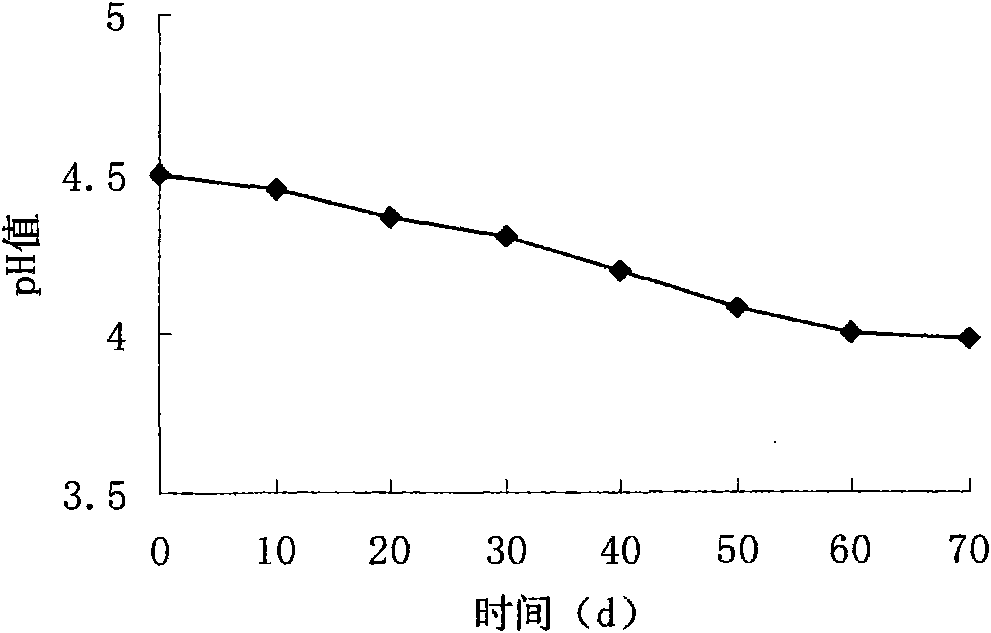Acid sensitivity lactobacillus bulgaricus strain and usage thereof
A technology of lactobacillus and acid sensitivity, applied in the field of bioengineering, can solve the problems of almost blank, weak acid production ability of fermented lactose, and late start of research, etc., achieve the effect of small acidity reduction, unique taste, and reduce production cost
- Summary
- Abstract
- Description
- Claims
- Application Information
AI Technical Summary
Problems solved by technology
Method used
Image
Examples
Embodiment 1
[0028] Example 1 Fermented yoghurt: use skimmed milk culture medium to carry out pure culture of acid-sensitive Lactobacillus bulgaricus L.B-FM-6 and Streptococcus thermophilus, and the cell numbers respectively reach 2.4×10 8 and 2.6×10 8 cfu / mL, after mixing at a ratio of 1:1, it is used as a starter for later use. The starter is inoculated in skimmed milk with an inoculum amount of 5%, and a sugar content of 8%, placed at a constant temperature of 43°C to ferment to pH 5.0, cooled and packed in aseptic tanks. Store at 4°C and 20°C, respectively, and measure the number of viable bacteria and pH value of fermented yoghurt at intervals of 7 days. The results are shown in figure 1 , figure 2 . When high-quality yogurt is consumed by consumers, its pH value should be 4.2 to 4.3. At a storage temperature of 4°C, the pH value of yogurt fermented with this starter is 4.38 after storage for 56 days, which is 35 days longer than the longest shelf life of yogurt currently on the ...
Embodiment 2
[0029] Example 2 Fermented vegetable juice: acid-sensitive Lactobacillus bulgaricus L.B-FM-6, Lactococcus lactis and Leuconostoc enteroenteritis were cultivated with whey compound medium respectively, and the number of cells reached 10 8 -10 9 cfu / mL, after mixing according to 2:1:3, it is used as a starter for later use. The starter is inoculated in the vegetable juice (the production of the fermented vegetable juice is carried out according to the following formula), the inoculum amount is 5%, and the temperature is 30° C. to ferment to pH 4.5, and then packed in aseptic cans. The product is sweet and sour and has a unique flavor. It is a new type of high-quality nutritional functional drink. Store at 4°C, measure the pH value of the fermented vegetable juice every 7 days, see the results image 3 . The pH value of fermented vegetable juice decreased slowly, and the shelf life of fermented vegetable juice was up to 60 days when stored at 4°C. Vegetable juice ( / L):
[00...
Embodiment 3
[0034] Example 3 Fermented fruit juice: acid-sensitive Lactobacillus bulgaricus L.B-FM-6, Lactococcus lactis, and Lactobacillus brevis were cultivated with whey compound medium, and the number of cells reached 10 8 -10 9 cfu / mL, Acetobacter aerlani was cultivated with acetic acid bacteria medium, and the number of cells reached 10 8 -10 9cfu / mL, after mixing according to 2:2:1:1, it is used as a starter for later use. The starter is inoculated in the fruit juice (the production of the fermented fruit juice is carried out according to the following formula), the inoculum amount is 5%, the temperature is 30° C. to ferment to pH 4.5, and it is packed in aseptic cans. The product is rich in fruity aroma, unique in flavor, suitable for sweet and sour, and rich in nutrition. It is a kind of active lactic acid bacteria beverage with high nutrition. Store at 4°C, measure the pH value of the fermented peach juice every 7 days, see the results Figure 4 , the shelf life of peach jui...
PUM
| Property | Measurement | Unit |
|---|---|---|
| Cell number | aaaaa | aaaaa |
| Cell number | aaaaa | aaaaa |
Abstract
Description
Claims
Application Information
 Login to View More
Login to View More - R&D
- Intellectual Property
- Life Sciences
- Materials
- Tech Scout
- Unparalleled Data Quality
- Higher Quality Content
- 60% Fewer Hallucinations
Browse by: Latest US Patents, China's latest patents, Technical Efficacy Thesaurus, Application Domain, Technology Topic, Popular Technical Reports.
© 2025 PatSnap. All rights reserved.Legal|Privacy policy|Modern Slavery Act Transparency Statement|Sitemap|About US| Contact US: help@patsnap.com



